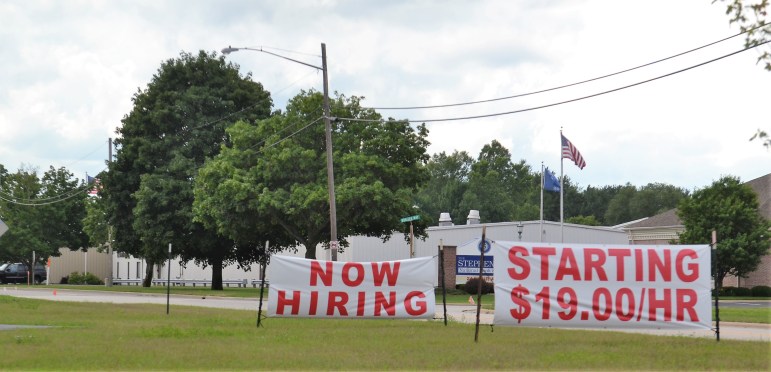Wisconsin manufacturers are less pessimistic than they were two years ago, and most still feel confident in their own businesses. But they still face major challenges when it comes to finding and keeping workers.
That’s according to a new report from the Wisconsin Center for Manufacturing & Productivity, which surveyed 400 manufacturing executives from across the state and conducted a series of focus groups.
The survey found that 39 percent of manufacturers said the economy was either slowing down or in a recession, down from 50 percent in 2022 but up slightly from 38 percent last year.
Stay informed on the latest news
Sign up for WPR’s email newsletter.
Buckley Brinkman, executive director of the center, said talking to manufacturers last year showed that many were deeply concerned about the possibility of a recession in 2024, but “that recession hasn’t materialized.”
“What a lot of these manufacturers are saying now is their customers are still working through the inventories that they built up during the pandemic, and those are coming down,” he said. “While their business is a little weak right now, they’re expecting it to rebound in 2025.”
Even so, the percentage of manufacturers who say the business climate is heading in the right direction dipped below 50 percent for the first time since the survey started in 2021.
Forty-seven percent said it was headed in the right direction, 31 percent said it was headed in the wrong direction and 22 percent had no opinion.
Brinkman said there’s a lot of uncertainty around the wider economy and the state of the world among manufacturers.
“No one’s jumping off the roof worried about the economy, but no one’s lighting off fireworks celebrating it either,” he said.
At the same time, the survey found that 85 percent of manufacturers remain confident about their company’s financial outlook, unchanged from 2023. But the share that were “very confident” about their business fell from 42 percent last year to 38 percent this year.
Among manufacturers with fewer than 50 employees, only one-third were “very confident,” while 47 percent of those with more than 50 employees were “very confident.”
“When we probed that, they were very confident in their own operations because they had it under control — the things that were within their four walls or within their purview, they felt very comfortable that they could handle whatever was coming at them,” he said. “When it got outside of their control, they weren’t so confident anymore.”
Ann Franz, executive director of the Northeast Wisconsin Manufacturing Alliance, said the report’s statewide findings were roughly the same as what she’s been hearing from manufacturers in her part of the state.
“Historically, every presidential election, every four years, there usually is a little bit of that ‘wait and see,’” she said. “People don’t want to do too much before they know who’s going to be the next president.”

Workforce, inflation top lists of concerns
Finding quality workers and retaining employees was listed as the most important issue affecting manufacturers and their future success, the report said.
Thirty-nine percent of manufacturers listed it among their top one or two issues, including 33 percent of small manufacturers and 57 percent of larger manufacturers.
“Unfortunately, we just do not have enough people living in this region to fill all the job opportunities,” Franz said. “When we look at birth rates, it’s not going to change. This is going to be always a problem, just because we just don’t have enough people.”
Inflation and rising costs was identified as the second biggest issue affecting manufacturers, with 26 percent listing it among their top one or two issues, the report said.
When conversations in the focus groups turned to inflation, Brinkman said that “almost none” of the conversation surrounded material costs and mostly focused on the cost of employees, ranging from wages to health care costs.
In fact, the share of manufacturers concerned about the costs of materials fell from 57 percent in 2022 to 43 percent this year. During the same period, the share of executives who were concerned about supply chains also fell from 53 percent to 35 percent.
At the same time, concerns about the costs of worker pay and benefits rose, up from 38 percent in 2022 to 42 percent this year.
“We definitely had wage inflation — we did not have enough people to fill all the jobs,” Franz said. “In order to keep people or find people, many companies increased the average wage as well as had hiring bonuses, along with things like offering special types of benefits.”
On the benefits end, health care costs specifically were a concern, with 85 percent of manufacturers who provide insurance expecting to see them increase this year.
That echoes a recent survey of 182 employers by Wisconsin Manufacturers & Commerce, the state’s largest business group. That survey found 44 percent of employers saw their health care costs increase by more than 10 percent over the last year, and another 41 percent saw costs go up between 6 and 10 percent.
Despite economic uncertainty and workforce challenges, Brinkman said most manufacturers say they can “deal with whatever’s coming.”
Wisconsin Public Radio, © Copyright 2024, Board of Regents of the University of Wisconsin System and Wisconsin Educational Communications Board.

